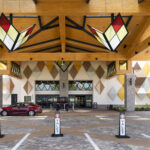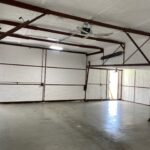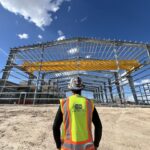Anyone exposed to current events over the past decade knows about the seriousness and timeliness of environmental responsibility, natural disasters and global climate change.
How hazards are prompting building resiliency and influencing codes

Flooding in New Iberia, La., after Hurricane Ike. (Photo courtesy of www.goodfreephotos.com)
Because of hazards like fire, hurricanes, floods, sub-zero cold snaps, earthquakes, and even terrorist attack, the concept of building resilience has come to the forefront. Resilience—the ability to resist and recover from disruption due to emergencies—is an important aspect of buildings, which must protect their occupants, and support recovery and resumption of normal operations after adverse events.
Building construction is being challenged with being better prepared and responsive to hazards through resiliency. Because of this resiliency push, legislation is prompting the adoption of better construction codes to protect buildings and people. Ensuring occupant and community health, safety, and welfare is the cornerstone of today’s building codes.
“Building codes are a fundamental contributor to community resilience,” says Ryan M. Colker, vice president of innovation, executive director of alliance for national and community resilience, International Code Council (ICC). “A community cannot be resilient without resilient buildings and the codes that support their development. As identified in the Code Council and Alliance for National & Community Resilience (ANCR) report, Building Community Resilience through Modern Model Building Codes, ‘Resilience in the built environment starts with strong, regularly adopted and properly administered building codes.’”

Benefit cost ratios from application of the 2018 IBC and IRC against hurricane winds. (Image courtesy of National Institute of Building Sciences)

Benefit cost ratios from application of the 2018 IBC and IRC against earthquakes.(Image courtesy of National Institute of Building Sciences)
Resilience Changes Codes
Is there proof that the concept of resiliency is changing codes? Yes, numerous studies have been conducted to date to determine the effectiveness of codes and support updates based on the resiliency lessons learned following disasters.
For example, Colker explains a 2014 analysis conducted by theFederal Emergency Management Agency(FEMA) estimated approximately $500 million in annualized loss avoided in eight southeastern states due to the adoption of modern building codes. Following major disasters, FEMA and the National Institute of Standards and Technology (NIST) conduct field evaluations and studies to determine the common modes of resiliency failure. These studies help identify where additional guidance or code and standard updates would lead to improved outcomes. “This feedback is applied to the code development process to ensure that codes capture the latest knowledge,” Colker adds. “Through regular updates of codes at the state and local level, communities can capture the benefits associated with research findings and new technologies and practices.”

Community functions contributing to resilience (Photo courtesy of Alliance for National & Community Resilience)
Metal industry associations recognize the general definition of building resilience as the ability of a building or other structure to minimize the effect of, adapt to and recover from disruptive events, and to continue operating as designed throughout its entire economic life. “Resilience may include only the building recovering from an event or in many cases it may include the minimization of occupant and business disruption before, during and following an event,” says Jonathan Humble, FAIA, NCARB, LEED AP BD+C, regional director, American Iron and Steel Institute (AISI). “Industry organizations and their members understand that a desire for increased resilience will have an impact on material selection. [They] naturally believe that steel is inherently resilient and should be the material of choice. The industry organizations have progressively been researching and developing improvements to their standards and other publications to address both resilience and sustainability concurrently. Many of these improvements have been to the published steel standards designed for use within the model building codes, as well as for state adopted codes.”
Humble cites one example of resilience testing changing codes is Metal Building Manufacturers Association (MBMA) and AISI sponsoring full-scale shake table tests at the University of California San Diego to better understand the performance of metal buildings in major earthquakes and to improve resilience. This knowledge helps provide design guidance that is reflected in publications such as the MBMA’s Seismic Design Guide.

This metal building system shake table tests and ensures resiliency and code compliance. (Photo courtesy of Metal Building Manufacturers Association)
Another example Humble cites is the Metal Construction Association’s responding to requests to create a standard for testing the edge metal used on roofing systems. The new standard ANSI/MCA FTS-1 “Test Method for Wind Load Resistance of Flashings Used with Metal Roof Systems” compliments the ASCE-7 standard 7 “Minimum Design Loads and Associated Criteria for Buildings and Other Structures” and the model building codes. This new standard was approved in June 2019.
Lester G. Meu, AIA, president of George Meu Associates, Oakland, Calif., and member of America Institute of Architects’ assistance committee says building codes have traditionally addressed the hazards of vertical and lateral loads as well as the corrosion and permanence of materials and systems, wildfire exposure and flood resistance. Meu believes codes are reactive in revising standards, which he calls an “involved consensus process.” However, “The ubiquity of natural hazard types to areas of the country previously seemingly immune could also be addressed by updates to the code’s structural design map areas for such items as wind speed, snow load, rainfall and ground motion, which would expand the already existing design standards to larger geographic areas.”
One way resilience in construction is moving from a philosophy to a prescriptive measure is via various steel industry standards and other publications, which Humble says bridges the dimension from concept to design and construction. “Updates to the steel standards [and codes] include a continual review of the durability, strength, ductility and other performance attributes of the steel,” he adds. “For example, the standards and other publications provide guidance on how to evaluate and specify the appropriate corrosion resistant coatings to ensure long-term durability, which is especially important for regions prone to flooding or regions with salt laden air. It is also beneficial to recognize that steel and its corrosion- resistant coatings are inorganic and, therefore, do not provide a food source for mold.”
Because some metal buildings, such as hospitals and schools, play a utility role in the event of emergencies, Sean Denniston, senior project manager at New Buildings Institute, says they need to remain operational as working buildings during hazards. “They play a big part in community resiliency and recovery after disasters,” he says. This resiliency-motivated functional recovery is gaining interest and influencing codes. Colker says the ICC is leading discussions on how to support functional recovery objectives within the existing code infrastructure, especially in the seismic community. “Functional recovery recognizes that buildings support multiple activities within a community as educational facilities, hospitals, housing and places of business,” Colker adds. “For a community to bounce back after an adverse event, these important community functions must be in place. Building in the expected time to recover for key buildings expands the importance of codes to recognize social and economic resilience. The concept of functional recovery is likely to extend to address other hazards as well.”

When evaluating seismic resiliency, cross-laminated timber has been found to be too rigid and special connectors must be created for its seismic components. However, steel is better suited for seismic resiliency and its connections are more commonly used. (Photo courtesy of Code Unlimited)
Humble contends that for construction products in general, resilience measures for building construction will remain a design methodology rather than a prescriptive measure. He believes this is because like many other requirements for building construction, steel must be designed and products selected for the environment where the building or structure is located. “For example, in California the structural primary focus is on seismic performance and fire-resistance performance, but in Florida the primary focus is on the resistance to high-wind forces and water intrusion as a result of the high wind, and so forth. Therefore, with each jurisdictional region there are unique environmental impacts that need to be considered individually and on a multi-hazard basis. While there are large corporate entities that do promote replicable building design (e.g., see ICC Guideline G-1”Replicable Building Design”) even those designs are site-specific and designed to comply with the regional environments within a jurisdiction.”
The influence of resiliency on codes is not only affecting new buildings but also retroactive retrofits; Humble contends this is making steel a material of choice. He cites The American Society of Civil Engineers (ASCE) Standard 41-17, “Seismic Evaluation and Retrofit of Existing Buildings,” and how it provides engineers and builders with a tool to effectively evaluate and optimize the seismic performance of existing buildings. “The standard addresses a difficult resilience issue for regions where seismic activity is a concern: how to ensure existing buildings, many of which were not built to withstand significant seismic activity, are able to remain standing and functional (if needed) during and after a seismic event,” he says.
Samir Mokashi, principal at Code Unlimited, Portland, says it is the industry’s better understanding of seismic forces that is influencing codes, citing a big change in the 1998 codes after the California earthquakes. Also, “There’s a lot of effort and discussions [affecting codes] going on in multiple jurisdictions on how to upgrade older, unreinforced structures, especially in Portland, Seattle and San Francisco where older buildings are collapsing and preventing emergency personnel from rescuing people. Also, the downtime of getting everything back on line because industries could not start up again after an earthquake— that’s getting a lot of attention.”
Energy Resilience and Codes
Denniston says he has seen the emerging concept of energy-system resiliency change codes and make buildings better. “In a disaster scenario, a really resilient building needs to have energy storage in place. In California, there is growth of on-site energy storage to meet energy codes. [Also, resilience is starting to affect] solar readiness codes. With zero energy buildings, they have the photovoltaics (PV) on the roof, but when the grid goes out the PV is worthless. Those PV systems need to be configured a little differently so they can continue to be useful in a disaster scenario. The International Energy Conservation Code (IECC) has an optional appendix about solar readiness. Places like Denver are thinking about making it mandatory; in California it is mandatory. Another set of code requirements coming through is storage readiness. Proposed to IECC, the idea that the building needs to be ready to add future storage, not just future PV, sets the stage for energy resilience in buildings.”

Symposiums and presentations like this on resiliency are influencing codes and building industry awareness. (Photo courtesy of Code Unlimited)
Wes Sullens, director of codes technical development,U.S. Green Building Council(USGBC), Washington, D.C., has experience with energy resilience and its affect on codes due to his involvement with the International Green Construction Code (IgCC), as published by ASHRAE and the ICC. “The 2018 version of IgCC has some elements of resilience embedded within the code, most notably because green building provisions tend to result in more adaptive and resilient buildings,” he says. “For instance, provisions in green codes help buildings protect occupants while also reducing impacts on resources should there be interruption in power or services following an extreme weather event. The green code has measures that: protect the indoor air quality of residents; use less energy; provide naturally day-lit buildings; and reduce water use through efficient plumbing fixtures and water systems.” Sullens says the USGBC is working to make resilience part of its LEED rating system, which will in turn further influence the future of building codes.
Going Above Resiliency Codes
To provide both minimum requirements and a framework for going beyond the code, Colker says resilience-related code provisions support the three “Rs” of resilience: robustness, redundancy and resourcefulness. “Communities or individual building owners could require enhanced strength and stiffness for seismic bracing or additional elevation to protect against increased storm surge or flooding as additional resilience measures are incorporated into code, durability, reliability and overall performance will further improve. Adoption and enforcement of the latest codes allows a community to establish a strong baseline. Additional activities like incentive programs for code programs lead to enhanced resilience. Tools like the ANCR Buildings Benchmark can give communities interested in beyond-code levels of resilience a framework for developing effective policies and practices.”
Buildings designed beyond the requirements of the code (above the minimum) are usually done so because of the building owner’s project requirements. Humble says this may include participating in a voluntary program or because the building owner has a set agenda for the final product. Meu believes, “Going beyond resiliency codes may incorporate more structural redundancy and hardening of the façade that can address multi-hazards and protect adjacent structures from cascading effects.”

(Photo courtesy of New Building Institute)
Denniston encourages going above resiliency codes and cautions value engineering—a common principle in building design and construction— may actually undermine building resiliency. “[Value engineering] brings buildings to just-the- bare minimum to meet a standard or project requirement or code. Our resiliency needs change over time which is something we are really encountering now. The buildings that are built to standards we had before are inadequate.”
Impact on Contractors
Contractors are on the front lines of implementing the resilient practices contained in building codes. But, their application of current resiliency codes will change to meet evolving resilience code requirements. For help with this, “Guidance from existing beyond-code programs may eventually find its way into the codes,” Colker says. “Contractors would be wise to learn about the content of the latest editions of the code—even if their localities are not up-to-date—and beyond code programs to help deliver resilient buildings to their clients. As interest in resilience grows, contractors should be prepared to offer retrofit solutions to their clients. Offering such a service can be a significant differentiator that brings in new business.” Humble says because of the resilience-affected codes, contractors when bidding on building projects will see differences in all aspects, which may include the primary structural frame, secondary members, connections and connections to other materials. “The steel standards provide information how to achieve those member types and connections. In addition, education is important to the contractor so that when constructing a building the construction crew understands the basis for the design in addition to how the building or structure is to be put together. This is why the various green, sustainable and high-performance programs emphasize the inclusion of the contractors’ contributions at the time of design.”





